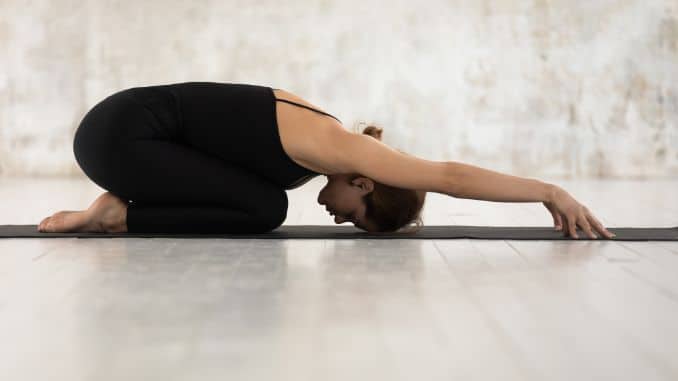Are you feeling drained and in need of a boost? If so, then give relaxing and restorative yoga poses a try. This type of yoga uses gravity to help you rejuvenate your body and mind. By using props like bolsters and blocks, you can fully support your body in each pose, allowing it to relax deeply and restore vital energy.
Whether recovering from an injury, dealing with stress or anxiety, or simply wanting to feel more centered and balanced, restorative yoga can help. So give yourself the gift of relaxation and try some gravity-assisted poses today.
Benefits of Restorative Yoga Poses
Restorative yoga is beneficial for those struggling with stress or anxiety. It's a powerful tool for achieving deep relaxation. The unique benefits of restorative yoga poses include the ability to relax and release tension in the body fully.
When stressed, our nervous system goes into overdrive, releasing a stress hormone such as cortisol. Over time, this can lead to various health problems, including a weakened immune system, high blood pressure, and digestive issues. Restorative yoga helps counteract these negative effects by lowering pressure, reducing inflammation, and boosting the immune system.
The primary benefit of restorative yoga is its ability to activate the parasympathetic nervous system, which is responsible for calming the mind. This contrasts with the sympathetic nervous system, which is activated during stress.
One of the key benefits of restorative yoga is its ability to help individuals experience a deep state of emotional relaxation. Holding each pose for an extended period, the body can fully release stress, leading to a deep sense of calm. This can also help improve sleep and alleviate chronic pain.
Additionally, restorative yoga helps improve flexibility and reduce muscle tension. It can also be customized to meet the specific needs of anyone. Various poses and modifications can target specific body areas and address specific concerns.
Calming the nervous system and boosting the immune system help improve overall health. This makes restorative yoga a highly adaptable yoga practice, whether you're a seasoned yogi or a newcomer.
Restorative Yoga: How to Achieve Deep Relaxation Response
Restorative yoga poses can help you unwind, relax, and revitalize your body and mind. Each type of this yoga pose is designed to be gentle and to take a break from the pressures of daily life.
1. Yin Yoga
Yin yoga is great for people who want to slow down and connect with their inner selves. This yoga hold poses for typically 3–5 minutes. The aim is to stretch the connective tissue and muscles. Yin yoga also stimulates the meridians, channels that carry energy, and improves the flow of prana throughout the body.
The long-held static poses during the Yin Yoga class allow the body to sink into the pose and gradually deepen the stretch. The focus is on breathing deeply and allowing gravity to do the work rather than using muscular effort to hold the pose. This releases any tightness in the muscles and connective tissues.
Connective tissue is a vital part of our body that supports our internal organs, muscles, and bones. However, it tends to be less flexible and more susceptible to injury. Yin yoga helps to improve the elasticity and flexibility of the connective tissue.
For those looking to unwind and destress, Yin Yoga is definitely worth a try.
2. Candles & Incense
Whether or not you practice restorative yoga poses, incorporating candles and incense can enhance your experience. The soft glow of candles and the gentle aroma of incense can create a calming and relaxing atmosphere, helping to soothe the mind. The flickering light of candles can also help to focus the mind during meditation or relaxation.
Using candles and incense can create a truly immersive experience that promotes relaxation and stress relief when combined with soothing music.
So, the next time you practice restorative yoga, consider including candles and incense to take your relaxation to the next level.
3. Props
Yoga practices promote relaxation and rejuvenation. Props such as a yoga mat, yoga blocks, and folded blankets are essential for creating a comfortable and safe environment for practicing restorative poses.
The yoga mat provides a cushioned surface for the body to rest on. Yoga blocks can support various poses, such as the supported bridge pose. And folded blankets provide support under the knees, lower back, or neck. This alleviates tension and provides a sense of comfort.
Whether in a yoga studio for a yoga class or at home, various props can help you achieve greater physical and mental benefits.
7 Restorative Yoga Poses
Restorative yoga practice is a form of gentle yoga. It's a therapeutic practice designed to help people relax and unwind. Restorative yoga poses help reduce pressure and improve sleep quality. It's also great for recovering from injuries or illnesses.
Here are the 7 popular restorative yoga poses that can be modified to meet the individual's needs. Regular practice is a wonderful way to take care of yourself.
1. Breaths
For this exercise, use a bolster, rolled towel, yoga block, or pillow to support your body comfortably.
Lie on your back on the floor with your knees bent and your feet flat on the floor. Place a bolster vertically under your upper body and a rolled towel horizontally under your nape as you bring your arms out to the sides. Bring your knees together and slightly widen your feet for comfort. Hold this pose for several deep belly breaths, in through your nose and out through your mouth. Relax and focus on deep breathing. Raise yourself back up to return to an upright sitting position.
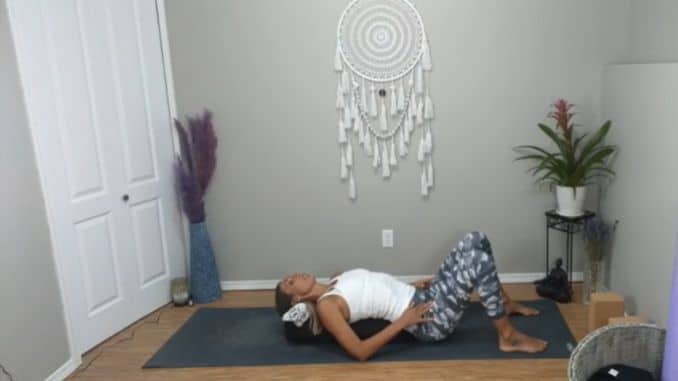
Breaths
2. Recline Cobbler’s Pose
For this exercise, use a bolster, yoga block, rolled towel or blanket, or pillow for support. This pose is also known as the reclining bound angle pose.
Lie on your back on the floor with the bolster lengthwise under your upper body and a rolled towel under your nape. Place a yoga block beside each knee for support. Extend your arms out at your sides, palms facing up, relaxing your upper body. Bring the soles of your feet together and open your knees out at your sides. Close your eyes and hold this pose for 8 deep belly breaths, in through your nose and out through your mouth. Relax and focus on deep breathing, releasing all the tension, then raise yourself back up to return to an upright sitting position.
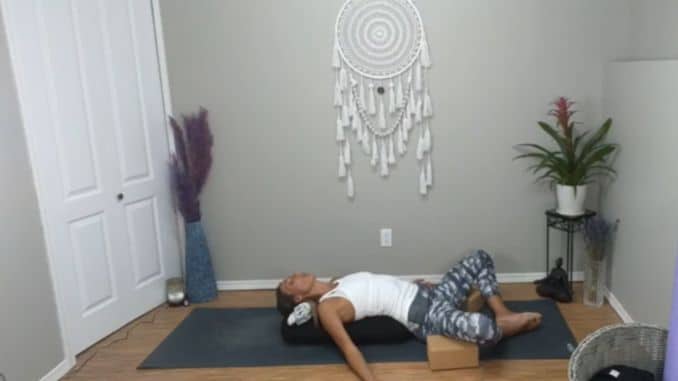
Recline Cobbler’s Pose
3. Supported Bridge
For this exercise, use a bolster, yoga block, rolled towel, folded blankets, or pillow to support your body comfortably. Lie on your back with your knees bent and your feet flat on the floor, relaxing your upper body. Maintain good alignment with your head, shoulders, and hips. Put a bolster horizontally under your hips and a rolled towel under your nape. Place your hands on your belly and bring your knees together, slightly widening your feet for comfort. Close your eyes and hold this pose for 8 deep belly breaths, in through your nose and out through your mouth. Relax and focus on deep breathing, releasing all the tension, then return to the starting position.
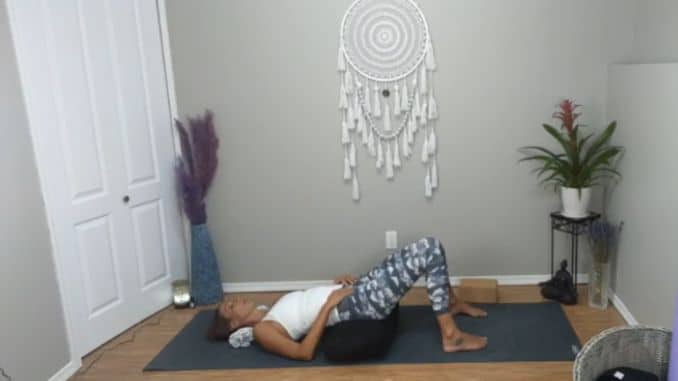
Supported Bridge
4. Spinal Twist
For this exercise, use a bolster, yoga block, rolled towel or blanket, or pillow to support your body comfortably.
Lie on your back with your knees bent and your feet flat on the floor. Place a bolster beside your hip for support. Extend your arms at your sides, relaxing your upper body. Straighten one leg and bring your bent knee towards your belly. Then twist through the low back and spine to bring your bent knee across your body. Lower your bent knee towards the bolster and hold the pose for 8 deep belly breaths, in through your nose and out through your mouth. Relax and focus on deep breathing, then repeat the movement on the opposite side.
Place a yoga block or pillow under the elbow for comfort.
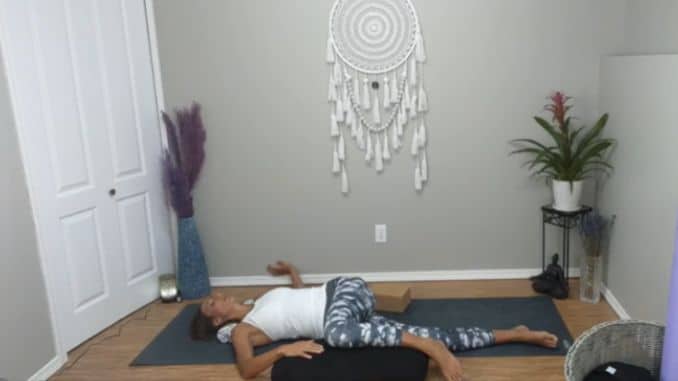
Spinal Twist
5. Legs Up on the Wall
For this exercise, use a bolster, yoga block, rolled towel or blanket, or pillow to support your body.
Lie on your back on the floor and extend your legs upward against the wall. Put a towel under your hips and a rolled towel under your nape. Place your hands on your belly and relax your shoulder blades and muscles. Hold the pose for 8 deep belly breaths, in through your nose and out through your mouth. Relax and focus on deep breathing, then return to an upright sitting position.
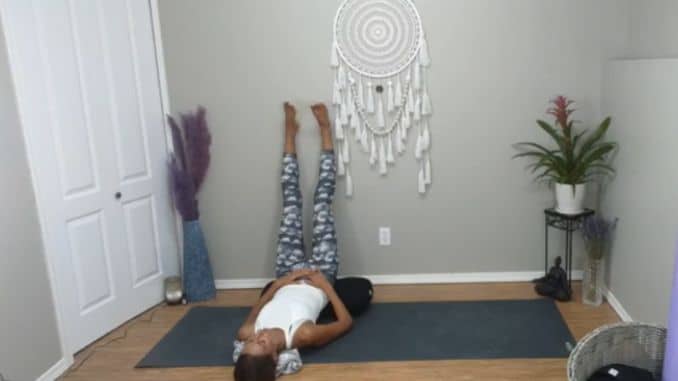
Legs Up on the Wall
6. Supported Child’s Pose
For this exercise, use a bolster, a rolled-up blanket or towel, or anything that lets your upper body be completely rested.
Begin in an upright kneeling position in front of the bolster with your knees wider than shoulder-width apart. Tighten your abdominal area. Shift your hips back to your feet and extend your arms in front, placing the bolster underneath your chest between your legs. Drop your forehead down on the pillow, relaxing your mid-back area for a light stretch. Hold this pose for 8 deep belly breaths, in through your nose and out through your mouth. Relax and return to the upright sitting position.
You can place rolled towels behind your knees for comfort.
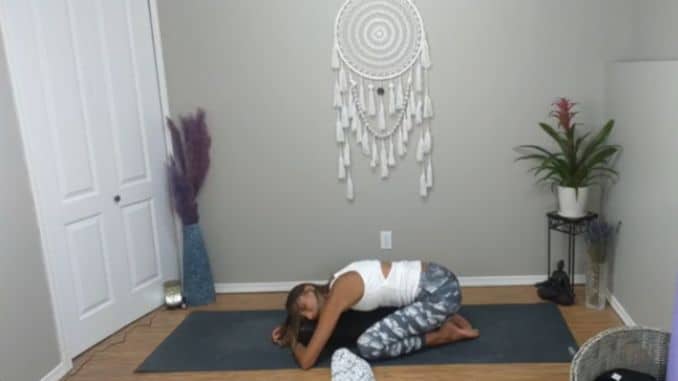
Supported Child’s Pose
7. Shavasana Pose (Corpse Pose)
For this exercise, use a rolled towel, bolster, blanket, or anything that lets your body relax.
Lie on your back on the floor, maintaining good alignment with your head, shoulders, hips, and legs. Place a towel under your nape and a bolster under your knees. Bring your blanket over your midsection and lower body if preferred. Engage your core and bring your arms to the side, palms facing up, as you close your eyes and relax your entire body. Hold this pose for several deep belly breaths, in through your nose and out through your mouth.
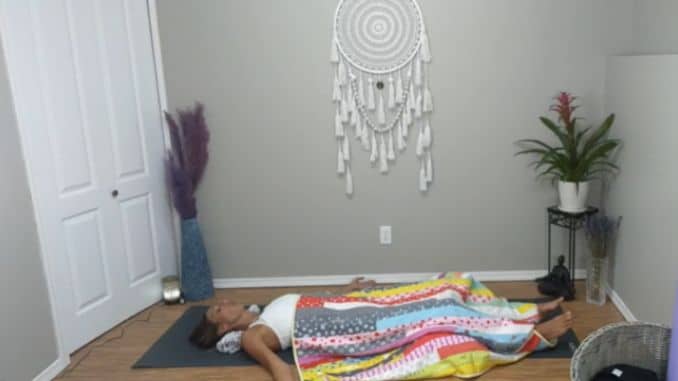
Shavasana Pose
FAQs
What are the 3 benefits of Yin Yoga?
Here are the 3 major benefits of Yin Yoga.
- Improves flexibility and joint mobility
- Reduces stress and anxiety by enhancing relaxation and mindfulness
- Improves circulation and reduces inflammation
Restorative yoga pose such as Yin Yoga is an excellent choice for those looking to reduce stress and improve well-being.
How many poses are in a restorative yoga class?
Restorative yoga is a gentle, relaxing practice that aims to soothe the body. It involves holding a series of passive poses for longer periods. While the number of poses in a restorative yoga class can vary depending on the teacher and the class duration, a typical session may include 5–10 poses.
Conclusion: Stress-Reducing Restorative Yoga
Restorative yoga offers a powerful tool for reducing stress and enhancing overall well-being. This gentle yoga emphasizes relaxation and deep breathing, encouraging the body to release tension and promote healing. You can achieve a calm mind and soothe the nervous system through gentle restorative yoga poses, bringing peace and tranquility.
Whether you are a beginner or an experienced yogi, restorative yoga can be a valuable addition to your wellness practice. Try restorative yoga if you're feeling overwhelmed and need some relaxation, and experience the physical and mental benefits it offers.

